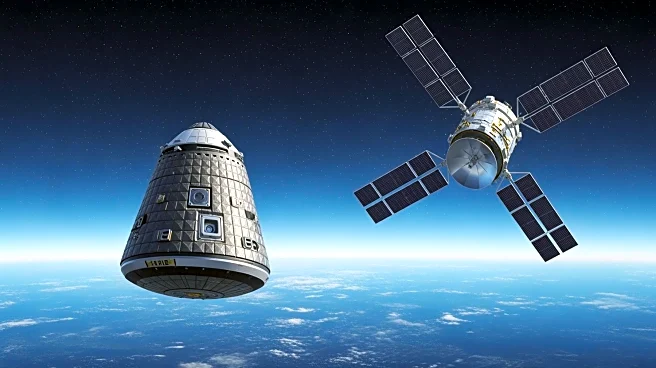What's Happening?
SpaceX's Starlink satellite constellation, which provides global internet coverage, is facing increasing threats from solar storms. Since May 2019, SpaceX has launched over 10,000 satellites, with about
1,000 re-entering Earth's atmosphere. During a solar storm in May 2024, Starlink satellites experienced altitude drops of up to half a kilometer due to increased atmospheric drag caused by solar radiation. This phenomenon affects the satellites' orbits, particularly those facing the sun and in regions like the South Atlantic Anomaly, where Earth's magnetic field is weaker. The interconnected nature of the Starlink network means that when one satellite adjusts its position, others must follow suit, creating a wave-like effect. This can lead to increased collision risks with other satellites and network disruptions, as evidenced by reported internet outages during the storm.
Why It's Important?
The susceptibility of satellite constellations like Starlink to solar storms has significant implications for global internet connectivity and satellite navigation. As the number of satellites in orbit increases, the potential for collisions and communication disruptions grows, posing challenges for operators and users worldwide. The impact of solar storms on satellite operations could lead to increased costs for maintenance and risk management. Additionally, the reliance on satellite internet in remote and underserved areas means that disruptions could have severe consequences for communities dependent on these services. The findings underscore the need for improved predictive models and strategies to mitigate the effects of solar activity on satellite infrastructure.
What's Next?
As solar activity is expected to peak again in the 2040s, satellite operators like SpaceX must prepare for more frequent and intense solar storms. This preparation may involve developing more robust satellite designs, enhancing predictive models for solar storm impacts, and implementing strategies to minimize collision risks. The growing number of satellites in orbit necessitates international cooperation and regulation to ensure safe and sustainable space operations. Researchers and industry stakeholders will likely focus on advancing technology to better predict and respond to space weather events, safeguarding the future of satellite-based services.
Beyond the Headlines
The challenges posed by solar storms highlight the broader issue of space weather's impact on modern technology. As satellite constellations become integral to global communication and navigation, understanding and mitigating space weather effects will be crucial. This situation also raises questions about the sustainability of current satellite deployment practices and the need for international collaboration in space traffic management. The research conducted using Starlink satellites provides valuable data for understanding atmospheric drag variations, contributing to the broader scientific understanding of space weather phenomena.












